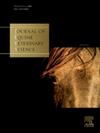Ice application without water drainage supports optimal hoof cooling in adult horses
IF 1.3
3区 农林科学
Q2 VETERINARY SCIENCES
引用次数: 0
Abstract
Cryotherapy is often used to reduce inflammation in acute equine laminitis cases. Certain hoof temperatures have been suggested as effective in minimizing the inflammatory process; however, there is limited evidence on which methods are best at achieving these temperatures. Our objective was to determine how different methods of cryotherapy influence the rate and extent of cooling for the equine hoof wall. Four horses received three hoof cooling treatments and a control (CON; no treatment application) in a 4 × 4 Latin square design. Treatments included (1) ice surrounding the hoof in a 5 L fluid bag with water drainage holes (DB), (2) ice surrounding the hoof in an undrained bag (UB), and (3) ice in a commercial wader boot (CW). Hoof wall temperatures were collected via thermal imaging for 12 h. Thermally imaged body temperatures and thermometer-based rectal temperatures, heat index, relative humidity, and ambient temperature were recorded. A treatment × time interaction (P < 0.001) was observed for all hoof temperatures. All treatments differed from CON after 2 h post-application, with the UB treatment resulting in the greatest and most sustained reduction in hoof temperatures over the 12 h period (a change of −23.7 °C ± 1.6). The wader boot showed similar trends to the UB treatment but was poorly tolerated by the horses. Environmental effects differed between hoof and body surface. Our findings indicate that cryotherapy treatments that maintain an ice-water slurry around the hoof result in greater decreases in hoof temperatures 2 h post-treatment compared to drained ice application.
冰应用不排水支持最佳的马蹄冷却在成年马。
冷冻疗法通常用于减轻急性马板炎病例的炎症。某些蹄温被认为可以有效地减少炎症过程;然而,关于哪种方法最能达到这些温度的证据有限。我们的目的是确定不同的冷冻治疗方法如何影响马蹄壁冷却的速度和程度。四匹马接受了三次马蹄冷却治疗和一次对照治疗(CON;无处理应用)4 × 4拉丁方设计。处理方法包括(1)将马蹄周围的冰放入5l带排水孔的液体袋(DB)中,(2)将马蹄周围的冰放入不排水袋(UB)中,以及(3)将马蹄周围的冰放入商业涉水靴(CW)中。通过热成像收集蹄壁温度12小时。记录热成像体温和基于体温计的直肠温度、热指数、相对湿度和环境温度。所有蹄温均存在 × 时间交互作用(P < 0.001)。施用后2小时,所有处理都与CON不同,在12小时内,UB处理的蹄温下降幅度最大,持续时间最长(变化幅度为-23.7°C±1.6)。长统靴与UB治疗有相似的趋势,但马的耐受性较差。蹄部和体表对环境的影响不同。我们的研究结果表明,与排水冰应用相比,冷冻疗法在马蹄周围保持冰水浆,在治疗后2小时马蹄温度下降幅度更大。
本文章由计算机程序翻译,如有差异,请以英文原文为准。
求助全文
约1分钟内获得全文
求助全文
来源期刊

Journal of Equine Veterinary Science
农林科学-兽医学
CiteScore
2.70
自引率
7.70%
发文量
249
审稿时长
77 days
期刊介绍:
Journal of Equine Veterinary Science (JEVS) is an international publication designed for the practicing equine veterinarian, equine researcher, and other equine health care specialist. Published monthly, each issue of JEVS includes original research, reviews, case reports, short communications, and clinical techniques from leaders in the equine veterinary field, covering such topics as laminitis, reproduction, infectious disease, parasitology, behavior, podology, internal medicine, surgery and nutrition.
 求助内容:
求助内容: 应助结果提醒方式:
应助结果提醒方式:


